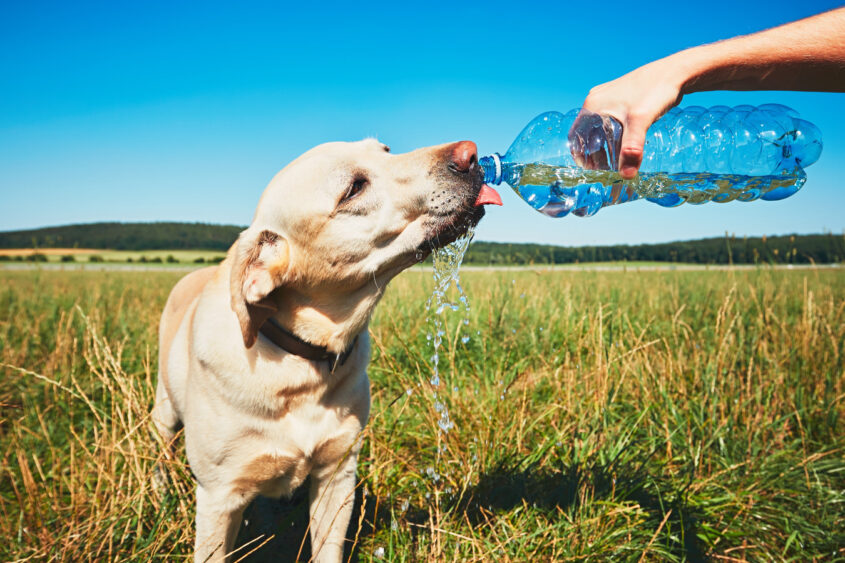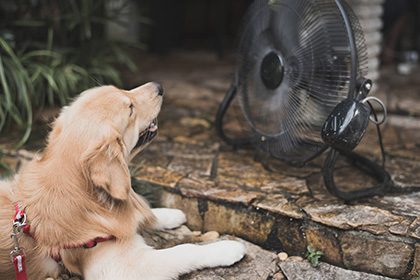Contents
Dogs pant as a normal way to regulate their body temperature, especially since they don’t sweat like humans do. However, excessive panting can sometimes indicate an underlying issue that requires attention.
Here are the most common reasons why your dog might be panting excessively.
Heatstroke

Heatstroke is a life-threatening condition that occurs when a dog’s body temperature rises to a dangerous level, usually due to long exposure to high temperature.
Dogs are particularly susceptible to heatstroke because they cannot cool down as efficiently as humans.
I’ve had first hand experience with Max having a heatstroke and it was a learning experience not to take him on a hike on a hot day.
Although we regularly did this hike in similar temperatures, he was especially excited that day as squirrels were all around leading to him overexerting himself.
First sign I noticed was his unusual rapid breathing. Second, he started to vomit after eating grass. ( which he never does after eating it ).
This was when it hit me that he was having a heat stroke.
Luckily, we were not too far from the car and I was able to get him to cool down with an air conditioner while heading to a vet nearby. He turned out OK and was released shortly after examination.
Symptoms of a dog having a heatstroke and the symptoms Max showed
Heavy Panting – Rapid, excessive panting is one of the earliest signs of heatstroke in dogs. They pant to regulate their body temperature, but if they cannot cool down adequately, it can lead to heatstroke.
Max’s irregular panting was the first sign that I knew something was off. Knowing your dog’s breathing pattern can save your dog’s life.
Excessive Drooling and Salivation – Dogs suffering from heatstroke may drool excessively, and their saliva may be thick and ropey.
Max was showing excessive drooling and it kept running down his mouth.
Vomiting and Diarrhea – Heat stroke can lead to gastrointestinal disturbances, resulting in vomiting and diarrhea.
Max started to eat grass with unusual urgency and started to throw up.
Gum and tongue changes color – The dog’s gums and tongue turns white, purple or blue due to lack of oxygenation in the blood.
I was not aware of this and was in too much of a hurry to get him to the vet at the time.
Rapid Heart Rate – The dog’s heart rate may increase significantly as the body tries to circulate blood to dissipate heat.
His breathing rate was off the charts and seemed to be in some sort of panic attack. He kept licking my face as if to say he’s worried and/or wanting help.
Increased Rectal Temperature – A rectal temperature of 104°F (40°C) or higher is indicative of heatstroke.
I did not have a rectal temperature at the time.
What to do if your dog is having a heatstroke
Move the dog to a cooler area – Get the dog out of direct sunlight and into a shaded, cool environment.

Provide cool water – Offer small amounts of cool (not cold) water to drink.
Wet the dog – You can spray or soak the dog’s body with cool water. Do not use ice water, as it can cause blood vessels to constrict, hindering heat dissipation.

Use fans and air conditioning – If available, use fans or air conditioning to help lower the dog’s body temperature.
Seek veterinary care – Even if your dog’s condition seems to improve, it’s important to seek immediate veterinary attention. Heatstroke can cause internal damage and organ failure, which may not be immediately apparent.
Preventing heatstroke
- Avoid exercising your dog during the hottest parts of the day
- Always provide access to fresh water and shade
- Never leave your dog in a parked car, even for a short time
- If your dog shows signs of distress in the heat, cool them down gradually and seek veterinary help if needed
Remember that heatstroke is a medical emergency, and prompt treatment can make a significant difference in the dog’s outcome.
2 Exercise
After physical activity or play, dogs may pant heavily to catch their breath and cool down. This is usually normal, but ensure your dog has enough rest and doesn’t overexert themselves.
3 Stress or Anxiety
Panting can be a sign of stress or anxiety in dogs. Changes in their environment, loud noises, or unfamiliar situations can trigger anxiety and lead to excessive panting.
4 Pain or Discomfort
Dogs may pant when they are in pain or feeling unwell. If your dog’s panting is accompanied by other signs of distress, it’s essential to have them examined by a veterinarian.
5 Poisoning
Ingestion of toxic substances can cause panting as a symptom. If you suspect your dog has ingested something harmful, seek immediate veterinary help.
6 Cushing’s Disease
This condition involves an overproduction of cortisol in the dog’s body, leading to increased panting among other symptoms.
7 Obesity
Overweight dogs may pant more frequently, as carrying extra weight can strain their respiratory system.
8 Illness or Medical Conditions
Certain medical conditions, such as respiratory problems, heart issues, fever, or infections, can cause excessive panting. If your dog’s panting is persistent and not related to heat or exercise, it’s crucial to seek veterinary attention.
If your dog’s panting seems excessive or unusual and is accompanied by other concerning symptoms, it’s best to consult with a veterinarian. They can conduct a thorough examination and determine the underlying cause of the panting to provide appropriate treatment or intervention if necessary.
Conclusion
Remember, dog’s can’t talk to us, so they rely on us to decipher their signals and needs.
If you notice your dog panting excessively, pay close attention to determine the underlying cause and act quickly if necessary.





